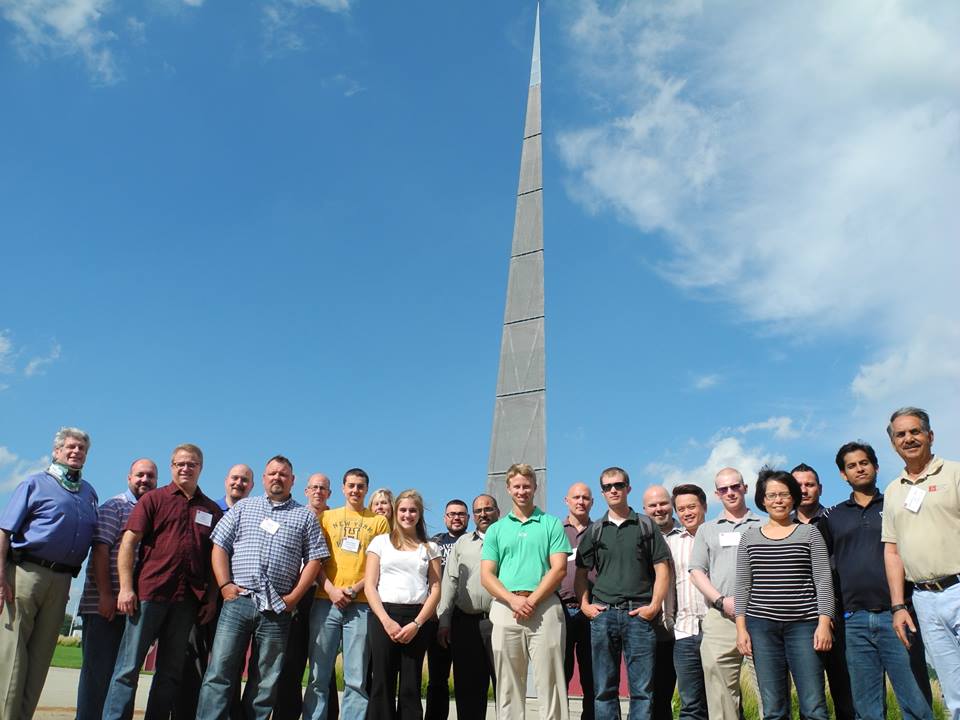
by Julie | Aug 25, 2016 | Employee Training, Management
CAN ANYONE SAY CAFFEINE?
Last week, I had the pleasure of being an instructor for the Investment Casting Institute’s Process Control Seminar. We had students from all over North America come together at Western Michigan University to learn how to apply process control tools in the three major areas of the investment casting process: wax, shell and foundry.
The structure of the course was for investment casting, but, there are definitely some takeaways which can be applied to all employee training.
- Provide multiple methods of learning. As I have previously discussed, everyone learns differently, so make sure you include visual, auditory and kinesthetic learning. Whenever possible, instructors should incorporate activities so the students can apply what they were learning.
- Tie the training back to something that can impact their jobs. Adults want to know that the effort in learning something new is worth it.
- Ensure the instructors are prepared and comfortable with the material they are presenting. We all know what an impact a great instructor can have on learning.
- Provide the training materials in different formats. Some people want their training materials electronically, while others prefer to have hard copies.
- Make sure caffeine is available throughout the day. Very few people are accustomed to sitting and listening to lectures for an entire day. Providing some stimulants, including chocolate, can help keep students focused.
- Control the environment. This includes the temperature of the room, noise in the hallways and conversations amongst students during the lectures.
- Get feedback on what can be improved. The perspective of the course should be evaluated from all angles, not just from the instructor. After the course, make sure to conduct a de-brief with the instructors while their experience is still fresh in their minds.
For more practical tips for manufacturing professionals to attract, train and retain your hourly workforce, go to www.keyprocessinnovations.com.

by Julie | Aug 22, 2016 | Interim Management, Management
A Long Term Strategy for Employee Motivation
I remember one of my first supervisory training classes I attended as a young engineer fresh out of college. One of the questions from the instructor was what do you do when your team is performing at the level you desire? I don’t remember all the potential answers to this multiple choice question, but, I do remember that I got the answer wrong. The correct answer was spend time with your team and get to know them better. I argued with the instructor and my co-workers that there was no need to get to know your team better, all people wanted was for their performance to be recognized through financial compensation, i.e. a bonus. It took me many years to realize how wrong I was and how right the instructor (and my peers) were.
What I have learned since that class is that pay is not a long term strategy for motivating your employees. Yes, short term it will motivate your employees to work hard, but, if you want consistent, high-performing employees, they need to find fulfillment in their work. That means that they find the work challenging and rewarding, they enjoy the people they work with and for and they feel appreciated.
Yes, we do work to pay our bills (well, most of us) but work isn’t just about making money. It is about feeling a level of satisfaction from the activity that we spend a majority of our time doing. If we were just working to make money, imagine how difficult it would be to consistently stay focused on the details of the job. But, if our employees feel appreciated doing something that they enjoy, that creates a much more productive work environment.
So, how do we go about creating this ideal work environment? It really does start with getting to know our employees and what they would like to accomplish. Some operators may have a desire to learn a new skill or make a different contribution to the company. Just because an employee has been in a particular position for a long time doesn’t mean he wants to stay there forever. Also, look for opportunities for employees to lead committees or company initiatives. What can’t be overlooked is the importance of making your employees feel appreciated. Sometimes appreciation can be as easy as a simple thank you. Or maybe a gift card to a local restaurant. Or an ice cream sundae in the heat of the summer. It has been my experience that the more spontaneous, the more it means to the employee.
When you come to work, are you feeling appreciated? If not, your employees probably aren’t feeling it either. Maybe it is time for a demonstration of appreciation.
For more practical tips for manufacturing professionals to attract, train and retain your hourly workforce, go to www.keyprocessinnovations.com.

by Julie | Aug 11, 2016 | Consulting, Interim Management, Management
ENHANCING YOUR TEAM’S EFFECTIVENESS
Recently I was reading about the Miracle on Ice when the US Men’s Hockey Team beat the Russians in the 1980 Winter Olympics. What I learned about this team was that the coach, Herb Brooks had to change his entire coaching philosophy in order to get a group of college rivals come together and work as a team. So, he made a deliberate decision to change his coaching style from an easy going guy to a “drill sergeant.” He was harsh, unyielding and ruthless, i.e. making them practice in the middle of the night. His objective was to get them to rally together due to their common hatred of their coach. And it worked.
I started to think about how a different leadership style can have an impact on a team. I think most managers are comfortable with situational leadership, where you adjust your leadership approach to meet the development level of an employee. But, few managers adapt their style in order to have an effect on the output of the team.
How might a change impact the performance of your team? If you sense your team is a bit complacent, perhaps a more direct approach might help improve the performance. Or if you sense a lot of tension among the team members, maybe a more approachable style will make team members more comfortable bringing up issues and asking for your help in resolving them.
If you do decide to make a change, make sure the reason for the change is clear in your mind along with the desired outcome. And changing things up needs to be consistent – your team will be confused if you are a drill sergeant one day and team psychologist the next day.
Who says change has to be a bad thing? If you can improve the output of your team, it may be worth the extra effort.
For more practical tips for manufacturing professionals to attract, train and retain your hourly workforce, go to www.keyprocessinnovations.com.

by Julie | Aug 4, 2016 | Efficiency, Interim Management
APPLYING WHAT ATHLETE’S KNOW INTO EVERY DAY LIFE
The 2016 Summer Olympics are almost here! I have such respect for the hard work, determination and sacrifices that these athletes make on a daily basis. So, in honor of the Summer Olympics, I thought I’d share some motivational quotes from our US Olympians which we can apply to our daily lives.
“We all have dreams. But in order to make dreams come into reality, it takes an awful lot of determination, dedication, self-discipline, and effort.”
–Jesse Owens, USA track and field gold medalist
“I learned that the only way you are going to get anywhere in life is to work hard at it. If you do, you’ll win. If you don’t, you won’t.”
–Bruce Jenner, USA medalist in the decathlon
“I’m trying to do the best I can. I’m not concerned about tomorrow, but with what goes on today.”
–Mark Spitz, USA gold medalist in swimming
“I like added pressure. It makes me work harder.”
–Mary Lou Retton, USA gold medalist in gymnastics
“There’s always a point where you get knocked down. But I draw on what I’ve learned on the track: If you work hard, things will work out.”
–Lolo Jones, Olympic hurdler
“Never underestimate the power of dreams and the influence of the human spirit. We are all the same in this notion: The potential for greatness lives within each of us.”
–Wilma Rudolph, USA gold medalist in track and field
“Focus, discipline, hard work, goal setting and, of course, the thrill of finally achieving your goals. These are all lessons in life.”
–Kristi Yamaguchi, USA gold medalist in figure skating
Go TEAM USA!

by Julie | Jul 28, 2016 | Consulting, Management
HOW NOT TO WORK AS A TEAM
Regardless of which side of the political aisle you sit on, I think we can agree that our government is a classic example of how not to work together. They engage in finger pointing, yelling, game playing and focus on the individual goals rather than the collective purpose. For those of us in the private sector, we couldn’t stay in business if we acted like our government.
So, if we can agree that our government isn’t a good example for healthy team work, what does a healthy team look like? As I reflect on my positive and negative experiences working on a team, I came up with the following which I believe are necessary to ensure a healthy team.
- A clear objective. Make sure that the team understands why they are working together. What are the collective objectives that the individuals are working towards? If they don’t know why they are working together, the team isn’t going to succeed.
- A desire for the team to succeed. If the team member or members aren’t committed to working together for good of the team, then ultimately, the individual motives will overcome the team objectives.
- A method for handling disagreements. Having differing opinions is normal, but, it is important that when opinions start to clash, there are guidelines in place to address the disagreements in a healthy manner.
- A willingness to hear the other side. We all can benefit from hearing others with a different opinion. Not just to respond to what they are saying, but, to really listen and understand.
- An ability to admit when we are wrong. As Zac Brown sang with Asyln, “you’re not always right, I’m not always wrong.”
- Accountability. Nothing will derail a team faster than individuals who aren’t held accountable for their contributions.
You may be able to name other requirements for a healthy team. But, I think this list is a good start to ensuring a healthy, functioning team. I’m sure we can agree that we want to be more functional than our federal government.
For more practical tips for manufacturing professionals to attract, train and retain your hourly workforce, go to www.keyprocessinnovations.com.





